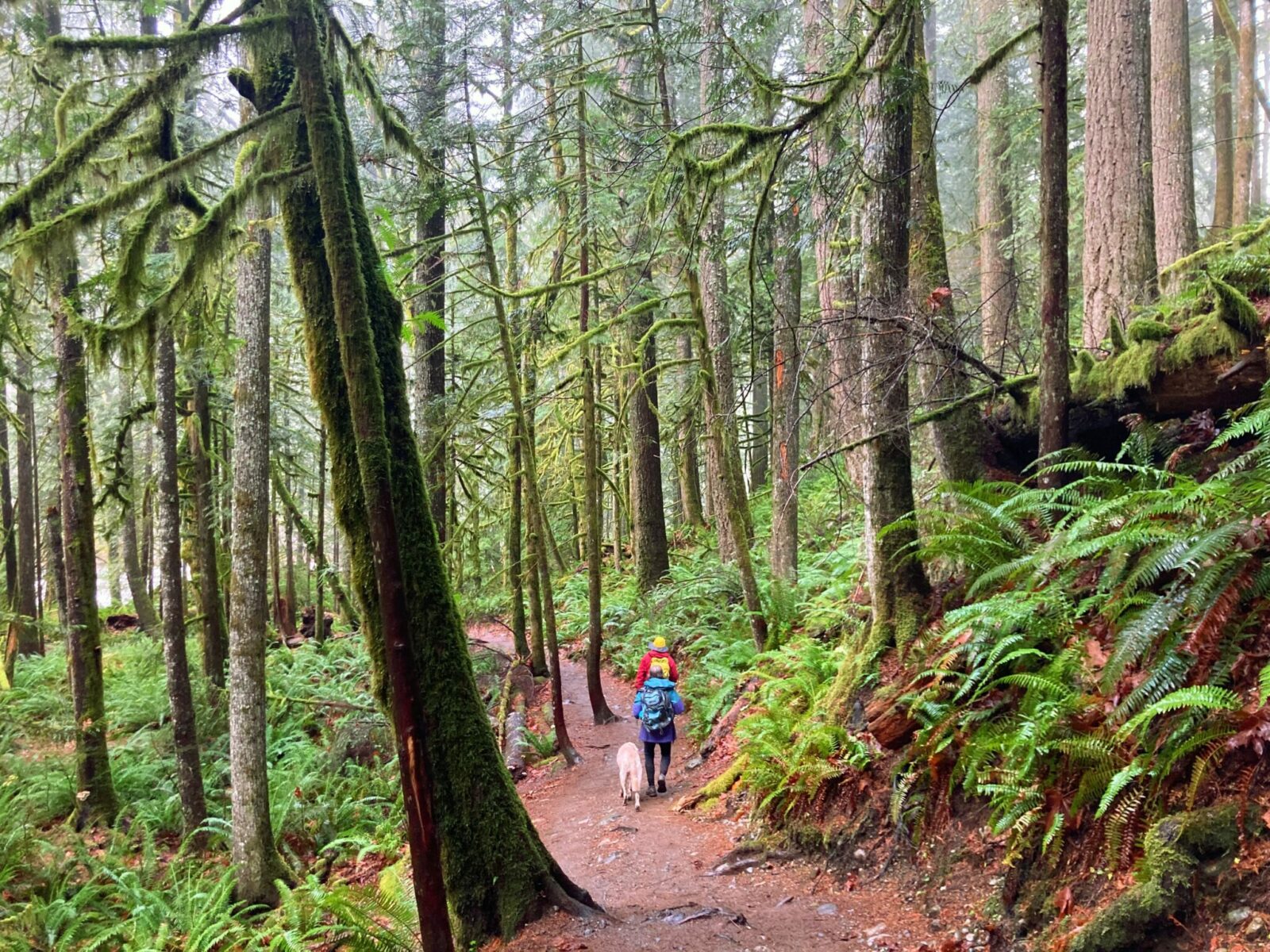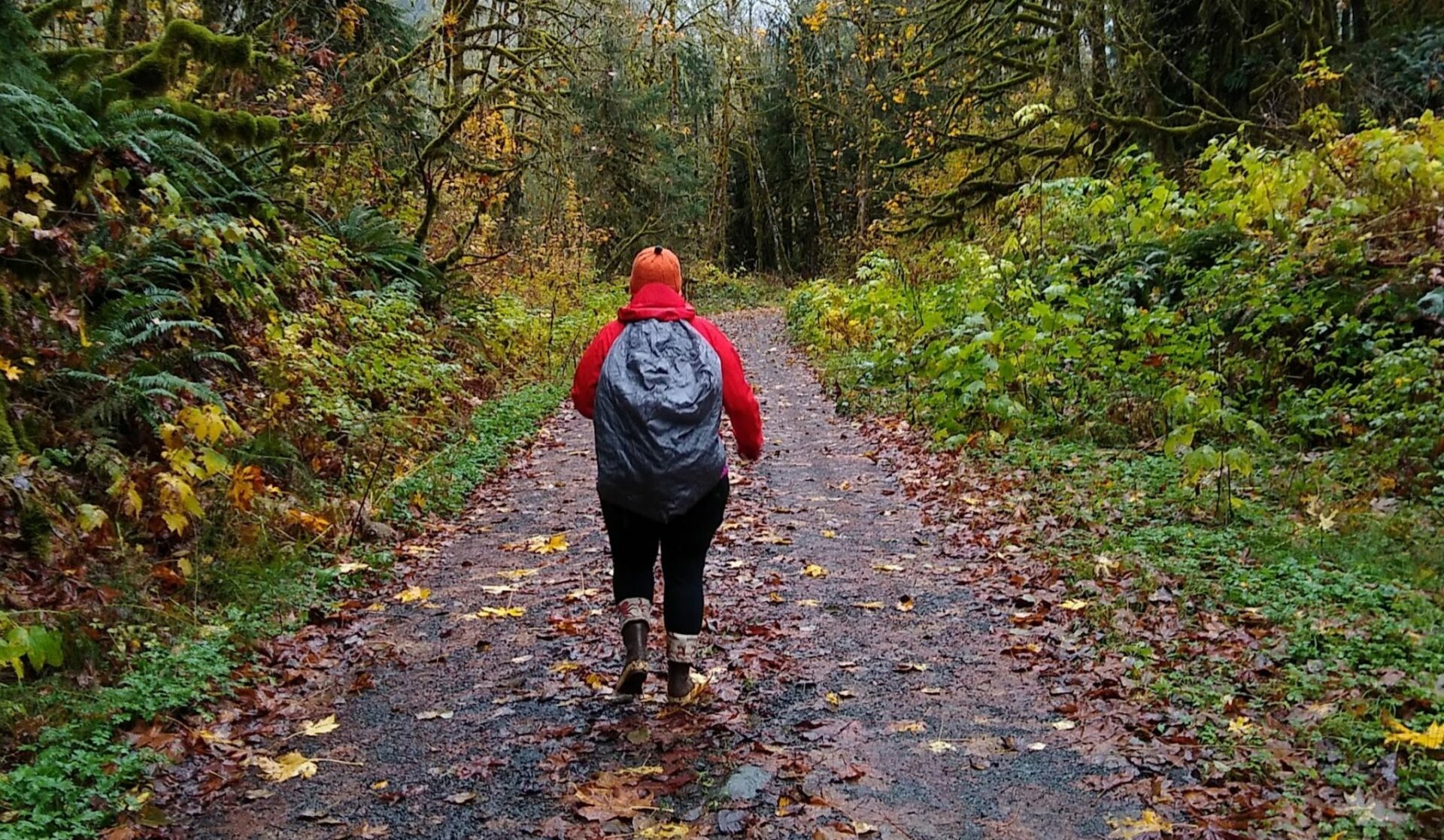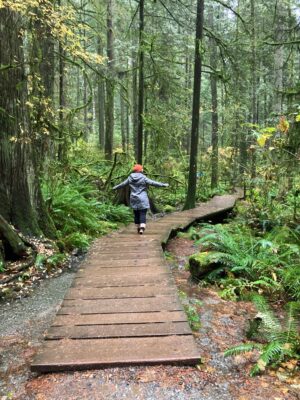Complete Guide to Hiking in the rain
Last Updated on December 9, 2024
As a born and raised Seattleite and former Alaskan, I have done a LOT of hiking in the rain! While it’s usually not most people’s first choice to hike when it’s raining, you can still have an amazing day outside with a bit of preparation and that’s what this article is all about.
There are two main ways to make hiking in the rain comfortable and fun – the first is to choose a location that will still be enjoyable on a rainy day and the second is to have the gear to keep you dry. The gear does not have to be complicated!
- Jump to picking the best location for hiking in the rain
- Jump to the best gear for hiking in the rain
- Jump to keeping camping gear dry if you’re backpacking
This post contains affiliate links, which means if you make a purchase I may receive a small commission at no additional cost to you. As an Amazon Associate, I earn from qualifying purchases.

Is it safe to hike when it’s raining?
While there is no guarantee of safety doing any outdoor activity, there’s no reason why hiking in the rain should be perfectly safe.
There are two major things to consider when it comes to safety and hiking in the rain.
The first is getting wet and cold and developing hypothermia, which is when your body temperature begins to drop and eventually it becomes fatal. Avoid this by making sure to bring some extra clothes (more than you think you’ll need) and staying dray with rain gear. More on gear below!
Another thing to pay attention to hiking in the rain is mud, slippery rocks and other hazards associated with wet weather. Take your time when it’s wet, make sure to wear shoes with good traction and consider using trekking poles. This can be an enormous help especially when navigating slippery trails and rocks.
Picking the best location for hiking in the rain

One of the most important things to do to enjoy hiking in the rain is to pick the right trail. Of course, sometimes rain can come up and surprise you, and then you can’t do much about your location once there!
Pay close attention to the forecast for the area you plan to hike in and plan a hike for a good location that you can enjoy in the rain. A few tips for choosing a good trail for hiking in the rain:
- If possible, avoid big view hikes – usually you’re not going to see the view, so if the only reason you’re there is for the big payoff, save it for a drier and clearer day!
- Look for a hike with things to enjoy along the way and make it more about the journey than the destination. For example, forest hikes can be downright magical in the rain. Same goes for hikes along rivers or at the beach.
- On any trail (and really this is always good advice), take it slow and don’t miss the small joys along the way you might otherwise miss out on. Look for slugs, mushrooms, wildflowers and the way the drops of rain on leaves and trees reflect the light
- When I’m hiking in the rain, I much prefer a trail without too much climbing and steep sections. This is partly a personal preference, but I prefer flatter trails on wet days because I’m less likely to slip or fall on mud or wet rocks, and I really don’t like getting sweaty in my rain gear.
- If it’s also going to be rainy on your drive, consider how far you want to drive in the rain. It could be a good time to do a hike with a shorter drive. Unless you love to drive in the rain, then go for it.

Related: Best rainy day hikes in Olympic National Park; Best rainy day hikes in Mt Rainier National Park
Best gear to stay dry hiking in the rain

If you’re going to a place where it’s fairly warm and rainy, I highly recommend an umbrella, because it keeps the rain off you without getting hot and clammy like you do in a rain jacket. A rainjacket and waterproof shoes are still a good idea, but an umbrella can be a complete game changer, especially for warm wet days.
Waterproof hiking clothes
The two most important pieces of clothing to have for hiking in the rain are waterproof shoes or boots with good traction and a rain jacket.
I also highly recommend having layers as it’s really easy to get hot in rain gear, but then cold when you stop moving. This is especially true when it’s raining. Have a layer that you don’t plan to wear hiking in your pack and make sure you have a lightweight layer for under your rain jacket.
Rain jacket
In my opinion it is absolutely essential to have armpit zippers (often called “core vents”) for ventiliation for a rain jacket that I’m going to wear while hiking. It makes sense a big difference if you get hot and sweaty inside a rain jacket like I do. I also recommend buying one size larger rain jacket than you would normally buy so you have plenty of room for warm layers under it if needed.
I love this marmot rain jacket. It’s durable (it has lasted several years of heavy use), waterproof and long enough to go over my hips. This REI one is very similar and also an excellent option. A big bonus for the REI one is that it comes in plus sizes too.
Hiking boots or shoes and wool socks
Many people wear waterproof hiking boots for hiking in the rain, which is an excellent choice. If you’re looking for some, I recommend Merrell (here on Amazon, here at REI).
I either wear rubber boots (these super cute ones are also really comfortable for hiking) or waterproof hiking shoes.
When it’s wet, it’s really important to have wool socks (more comfortable if they do get wet) and I recommend bringing an extra dry pair in a ziploc in your pack. That way if you get in water that goes over the top, you can put on dry socks! Dry socks even in wet shoes is a complete game changer. Give it a try!
Rain Pants and Leggings
I find rain pants really uncomfortable to wear, but I do always carry them in my backpack. I like these REI ones that come in plus sizes. Usually I wear leggings for wet hikes since when they get wet they’re still fairly comfortable (unlike hiking pants).
Keeping your gear dry
I highly recommend getting a pack cover like this one from REI. It’s a fairly inexpensive item, and it makes a huge difference if you can keep everything in your pack dry! Make sure you get the size that is appropriate for your backpack. The cover will tell you what capacity it is and make sure that’s the same as your pack.
Ziploc bags are really helpful for keeping things dry as well, like an extra pair of socks or gloves or snacks! No one likes a soggy sandwich. Ewww.
Related: What to wear for a hike in the Pacific Northwest, What to bring for a hike in the Pacific Northwest

Keeping your camping gear dry if you’re backpacking
This article is mostly focused on day hiking, but a few tips if you’re backpacking. Definitely use the dry socks in a ziploc trick.
For backpacking (multi-day hikes) it’s more important to make sure everything stays dry. Use a pack cover that fits over the whole pack. I also recommend putting your sleeping bag and sleeping pad inside a garbage bag. You can also pack clothes in garbage bags or gallon ziplocs.
Another trick for backpacking if you have to set up or break down your tent in the rain (which is NOT my favorite) is to get everything packed inside the tent, then get your rain gear on and break down the tent as quickly as you can. It really helps if you practice at home if it’s a new tent! I like to wrap up the rain fly (which is already wet anyway) and attach it to the outside of the pack so it doesn’t get everything else wet.
When setting up in the rain, try to do it as quickly as possible and put your backpack (after removing the pack cover in the tent right away. Keep rain gear, the pack cover and boots in the vestibule of the tent so they are under cover but don’t get everything wet inside the tent.









